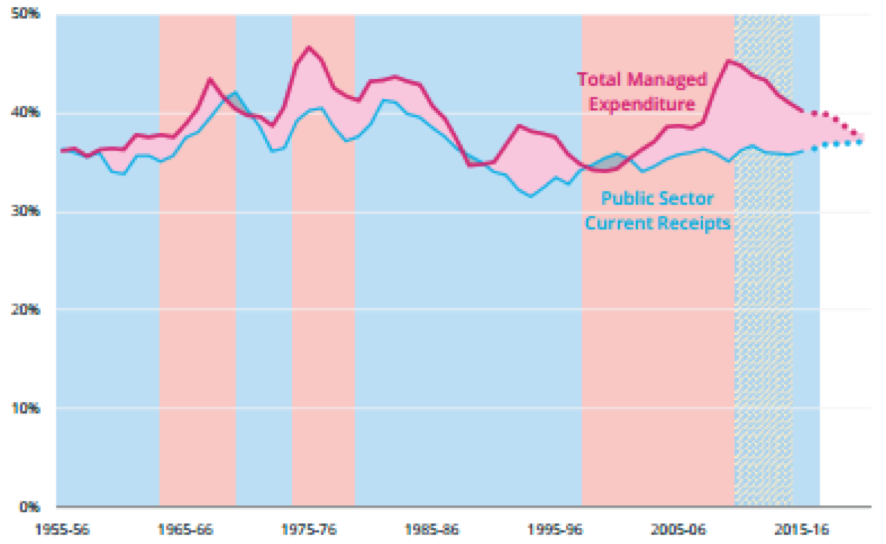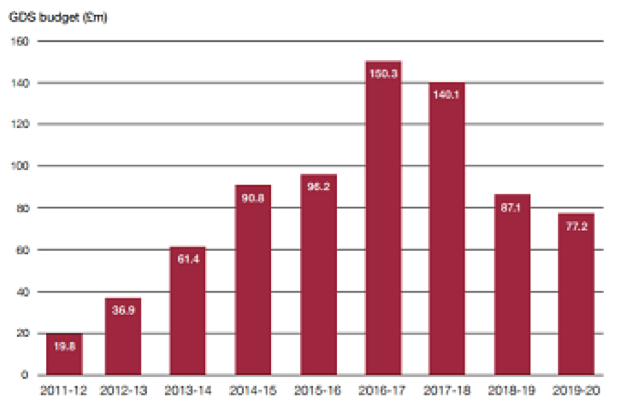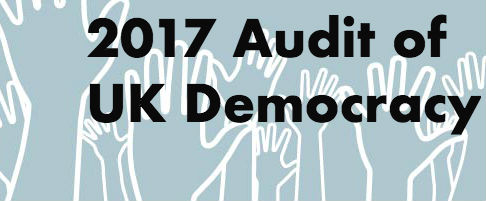Audit 2017: How representative and effective are the UK civil service and the wider public services management system?
As part of our 2017 Audit of UK Democracy, Patrick Dunleavy looks at how well the administrative wings of the British state operate – especially the traditionally dominant civil service headquartered in Whitehall, but also the wider administration of key public services, notably the NHS, policing and local government administrations. Are public managers at all levels of the UK and England accountable enough to citizens, public opinion and elected representatives and legislatures? And how representative of, and in touch with, modern Britain are public bureaucracies?

The Government Digital Service Team celebrate the launch of gov.uk in 2012. Photo: gdsteam via a CC-BY-2.0 licence
This article was published as part of our 2017 Audit of UK democracy. We have now published: The UK’s Changing Democracy: The 2018 Democratic Audit with LSE Press, available in all ebook formats. You can download the whole book for free, and individual chapters, including a fully revised version of this article.
What does democracy require for how Whitehall and the national civil service operates, along with wider public service delivery systems?
- Policy-making about services provision and implementation, and about the regulation of social and economic activities, should be controlled by democratically elected officials so far as possible, and should be deliberative, carefully considering all the interests of all relevant actors. Before significant policy or implementation changes are made, fair and equal consultation arrangements should allow service recipients and other stakeholders to make inputs into decisions, especially where services are being withdrawn or rights are being constrained.
- Public administration at all levels of government and the delivery of public services should be impartially conducted within administrators’ legally available powers. All citizens should have full and equal access to government and to the beneficial services and goods to which they are entitled, without discriminatory provisions applying to any group. The human rights of all citizens should be carefully protected in decision-making, and ‘due process’ followed in adjudicating about their cases or entitlements.
- Where ‘para-state’ organisations deliver services on behalf of or subsidised by government (e.g. NGOs or private contractors) action within the law, equal treatment and access, respect for human rights, and freedom from corruption should all apply in exactly the same way. Public services, contracting and regulation should be completely free from corruption, with swift action taken against evidence of possible offences.
- The importance of these ‘public value’ considerations is especially heightened in government regulatory activities, cases of compulsory consumption, where service users face any form of ‘coerced exchange’ choices, or where consumers depend heavily on professional expertise or are subject to the exercise of state or professional power.
- The civil service and public services organisations should recruit and promote staff on merit, taking due regard for the need to combat wider societal discrimination that may exist on grounds of race, ethnicity, gender, disability or other factors.
- Ideally, public administrations will be ‘representative bureaucracies’ whose social make-up reflects (as far as possible) that of the populations they are serving. Where differences in the social make-up of the people delivering and receiving public service has significant implications for the understanding, legitimacy and perceived quality of services, the delivery organisation must demonstrate committed efforts to overcome recruitment biases.
- Government-organised and subsidised services should be efficient and deliver ‘value for money’. Costs should be reasonable and competitive, and the activities and outputs should be produced using technologies that are modern, and kept under review, using best practice methods. Over time the productivity of government-organised and -subsidised services should grow, ideally at or above the societal average level.
- The efficacy of government interventions and regulations should be carefully assessed in a balanced and evidence-based way, allowing for consultation not just with organised stakeholders but also with unorganised sets of people affected, or interest groups active on their behalf.
- Regulation and de-regulation should both be implemented in balanced, up-to-date and precautionary ways that safeguard public safety and the public interest, but keep the economic and transaction costs of regulation to the minimum needed.
- Point of service standards in the public services should keep pace with and be comparable to those in other modern sectors. Procedures for complaints and citizen redress should be easy to access and use, and public service delivery agencies should operate them in transparent and responsive ways, fulfilling ‘freedom of information’ requirements.
- Where mistakes happen, and especially where public service delivery disasters occur that seriously harm one or a few person, or that adversely affect large number of people, public service organisations should show a committed approach to recognising and rectifying problems, and to rapid organisational learning to prevent them from recurring.
In liberal democracies, citizens and politicians expect that public service organisations and the civil service will meet all of the multiple requirements listed above, simultaneously. If lapses occur in any aspect, public trust in these bodies can be severely impaired, usually increasing their costs appreciably and reducing their abilities to get things done.
Yet the different expectations listed above clearly crosscut each other. For instance, carefully consulting and respecting human rights adds expense and time to government agencies’ processes. So it may curtail their ability to reform, and impair efficiency-seeking and cost containment. Similarly, treating people equally means that agencies cannot do what firms do, and focus just on those customers who are easy or profitable to serve, turning their backs on difficult cases. Yet agencies are expected to match firms in terms of productivity growth. Public management involves handling these dilemmas so as to (somehow) steer a course between them that maximises public value.
Recent developments
The recent history of public services has been dominated by the austerity programme of the 2010-15 Conservative-Liberal Democrat government, which sought to restore a balance between public spending and government revenues, primarily by cutting back welfare payments and the running costs of public services. Chart 1 shows that their plan sought a rarely achieved balance of current spending and receipts by 2020, with public spending stable at around 37% of GDP – pretty much above the level it has been since the late 1980s.
Chart 1: Tax receipts, public spending and UK deficits as a proportion of gross domestic product over time

Source: Institute for Government, p.35.
The NHS was exempted from austerity with spending maintained in real terms, but the higher costs of health inflation not covered. Most spending cuts focused on welfare benefits, policing, prisons, and devolved and local government services, with the civil service exporting many cutbacks to other agencies to accomplish. Nonetheless Whitehall running costs were also targeted and the number of civil servants fell below 385,000 – its lowest level since 1940 (when the UK’s population was also far smaller).
Chart 2: The size of the UK civil service over time

Source: Institute for Government, p.4.
Yet much of this fall may be rather cosmetic, because of the growth of a para-state of contractors (and a few NGOs) who now carry out functions previously done by Whitehall but do not count in the personnel numbers. In 2016 the UK government as a whole spent as much on contracting with firms for goods and services as it did on paying public sector salaries.
The Labour general election campaign in 2017 called for an end to austerity and this apparently chimed with the public, especially when three terrorist attacks occurred near or during the campaign, drawing attention to reductions of 20,000 in police numbers. The austerity policy’s imposition of 1% pay rises on all public sector workers (cutting their real pay by around 2% a year) also sparked controversy. Shortly after the election, the catastrophic fire at a council high rise block, Grenfell Tower (which killed 80 people) focused attention on cutbacks made in regulatory provisions. Apparently some 260 other high rise blocks had been fitted with highly inflammable cladding and insulation that should have been banned. Successive deregulation initiatives, plus severe cutbacks in the fire service’s inspection capacities, meant that no effective fire safety checks seem to have operated for many years.
Strengths, Weaknesses, Opportunities, Threats (SWOT) analysis
| Current strengths | Current weaknesses |
|---|---|
| The UK civil service model has a long tradition of being very politically controllable and accountable. Its culture is generalist and non-partisan, able to work with governments of different partisanship and to tackle new issues with some competence. Departmental viewpoints are strong in Whitehall, but less so than in many countries thanks to cross-departmental movements of personnel over their careers. | The dominance of the generalist ‘policy profession’ in Whitehall feeds into and encourages a pattern of policy-making that overvalues short-run administrative and organisational changes as keys for increasing public policy effectiveness. This undervalues the importance of long-run and substantive changes reliant on greater policy-specific expertise. |
| Officials are individually and collectively responsive to public opinion, keen to avoid criticisms, and committed to equal treatment of citizens at the point of service. These qualities are replicated in other public services. | There is no statutory protection of civil servant independence. The ‘Armstrong Doctrine’ holds that ‘the civil service has no constitutional personality separate from that of the government of the day’. So UK senior civil servants have only a weak capacity to ‘speak truth to power’, and especially have not been able to curtail ministerial hyper-activism, pointless party political policy churn, and legislation that was little used after its passage into law. |
| Public administration in the UK is generally effective and reasonably modern. The civil service has a well-developed pattern of continuously or regularly undertaking reforms and looking for best practices elsewhere to adopt. The UK’s record in digitally transforming public services is a reasonable if not outstanding one, especially in the heyday of the Government Digital Service (2011-15) – see below. | The NPM organisational culture means that senior UK civil service officials may be party-politically neutral, but show a chronic bias towards ‘new public management’ beliefs – especially in over-valuing ‘managerialism’ and ‘leaderism’ compared to evidence-based policy-making. |
| Whitehall has a strong tradition of contingency planning and rallying around in resilient ways in crises, plus an ability to see issues through despite scarce resources. | The same over-orientation towards managerial reorganisations and strong leadership has been spread strongly into policing, local government and the NHS by Whitehall interventions. |
| Corruption and fraud in the civil service is rare and this pattern has been extended into devolved governments and most local government over time. | The ‘revolving door’ denotes a set-up where senior mandarins can retire or leave their posts, but then move into private consultancy jobs or posts in public service contractor firms. Critics argue that it also creates a pro-outsourcing NPM bias. Rules supposedly safeguarding the public interest by limiting moves to beneficial jobs are only weakly enforced, as a 2017 NAO report noted. |
| The increased financial involvement of private sector firms in delivering critical public services (via privatisation, the Private Finance Initiative and Public-Private Partnerships) has sometimes worked. But at other times it has weakened the stability of public service, importing new sources of financial instability and poor productivity change (see below). | |
| There have been some notable and recurrent lapses in the equal treatment of some black and ethnic minority citizens, women and physically or mentally disabled people within the police, prisons service, NHS and local government, with a succession of adverse scandals. | |
| Citizen redress processes have always been weak in conventional public services (see below). They have been made far more complex and often impenetrable by the growth of contracting and commissioning of private sector firms and NGOs in many welfare state and social services. Legal and administrative provision for complaints and redress in these areas lags many years behind organisational best practice. | |
| A few corruption blackspots remain, especially in areas like overseas sales of defence equipment, and private contractors taking over government-run services on a payment-by-results basis. |
| Future opportunities | Future threats |
|---|---|
| The Brexit move to ‘take back control’ (and its many associated difficulties) may create an ‘overload’ at the centre that impels both ministers and Whitehall and the civil service to cease blocking the delegation of more powers and freedoms to devolved and local governments. | The burden of new legislation and statutory instruments imposed by any abrupt Brexit transition could overload Whitehall capacities, but might be handled better given an extended transition period. An early Deloitte consultants' report argued that Whitehall really needed 30,000 more civil servants to process over 500 Brexit-related projects, sparking angry denunciations by the May government. |
| The growing use of social media (aided by the pervasive use of mobile phone cameras to generate photo and video images) has greatly increased the specificity and rapidity of citizen vigilance. The potential ‘audience reach’ of criticisms, and the speed and salience of news of mistakes, have also increased. Officials now confront a stronger discipline of public criticisms. So perhaps responsiveness - in better explaining policies, and in quickly correcting mistakes or services lapses - may improve. | The UK civil service will need to rebuild key skill sets and forms of expertise (e.g. in trade negotiations or strategic economic regulation), which have been wound down during the 43 years of EU membership. These cannot be easily or quickly put in place, and will be costly to recreate. |
| The planned extensive use of ‘Henry VIII’ powers in the Brexit transition to make new executive orders with little Parliamentary or public scrutiny means some Whitehall powers may go unchecked. | |
| As austerity eases off some the pressure for digital changes has also ebbed, with the GDS budget cut back and an absence of any clear ministerial lead (see below). | |
| The longer that public sector pay remains artificially constrained by the 1% salary cap, the greater the pent-up salary bill problems in public services become. A loss of EU migration may also adversely impact labour shortages, e.g. in the NHS. | |
| 'New public management' strategies plus many years of austerity policies have worn thin the UK state’s capacity to cope with crises and unexpected contingencies. The August 2011 riots in London and other cities showed one kind of vulnerability, eventually requiring 16,000 police on the streets to bring them to an end. And the 2017 Grenfell Tower disaster and scandals around building safety de-regulation demonstrated another facet of the same underlying fragility. |
New public management, austerity and ‘zombie NPM’
Critics of conservative, state-shrinking policies often characterise them as ‘neoliberal’, and see uncaring senior officials as complicit in over-cutting government provision. In fact public servants in the UK from the 1980s to around 2005 bought into a rather different set of doctrines called ‘new public management’ or NPM. Its central themes were
- disaggregation (chunking up large bureaucratic hierarchies into smaller organisations) to improve responsiveness;
- competition (especially between in-house providers and private contractors) to improve efficiency; and
- incentivisation (paying officials and contractors by results) to improve motivations for hitting targets.
NPM continued under the Blair/Brown governments – but in more ‘humanised’ ways, and with concessions to trade union interests.
Many commentators confidently predicted that the Coalition government in 2010 would return NPM ideas to centre stage, not least because they had been the orthodoxy when Tory ministers had last been in power (back in 1996-7). But in fact only one or two NPM-style changes were made – below the Whitehall level. They were implemented in a ‘zombie NPM’ style that soon ran into opposition, causing the intended changes to be heavily modified. ‘Free schools’, for instance, were supposed to boost competition and expand choice, but soon ran into regulatory problems, limiting their spread. The Cameron government also made some play with the idea of backing a ‘Big Society’ in 2010-2013 (supposedly preferable to a ‘big state’, and thus providing some ideological cover for austerity). This concept was always tenuous, especially as NGOs and the third sector were among the first to suffer from cutbacks. It disappeared for good after a Commons select committee found little substance to it.
The chief NPM ‘reform’ was a reorganisation of NHS administrative structures pushed through by Cameron’s first health minister, Andrew Lansley. Eventually implemented by 2013, at a huge cost (between £2.5bn and £4bn), it created Care Commissioning Groups, supposedly run by consortia of GPs. CCGs ‘buy’ services from NHS acute hospitals, which were also mandated to ‘commission’ more services so as to allow more private firms to bid for ‘work packages’. The result was a massively complex ‘quasi-market’ scheme that Cameron had to ‘pause’ and try to simplify, before it was finally put into action. Of the promised CCG improvements in commissioning and savings in management costs there has been little or no sign, and instead acute controversies over a ‘postcode lottery’ in access to costly drugs or fertility treatments. And some prominent private sector contracts for acute hospital services have already failed.
Meanwhile in Whitehall austerity meant reversing earlier NPM changes. The high salaries for leaders under ‘incentivisation’ schemes proved unaffordable, as did the luxury of multiple agencies created in the 1990s. Top pay was promptly capped to the level of the PM’s salary, and many agencies re-absorbed into central department groups. ‘Light touch’ regulation supposed to encourage competition collapsed in financial markets in 2008-10, prompting a huge prudential re-regulation by 2015. The Grenfell Tower disaster in spring 2017 showed that the finance case was not an isolated one, with fire safety and building controls deregulated into meaninglessness.
Detailed analysis of new public management’s claims to have saved money and improved government efficiency also suggested that the whole NPM experiment had not realised any cost reductions or efficiency improvements. And while the structural costs of austerity were diffused, by 2017 evidence accumulated that their consequences had become potentially far-reaching. For example, the annual growth in UK life expectancy, which had been strong before 2010, slowed to a complete standstill after 2011, for no clear reason except the increased stress placed on the NHS.
Digital era governance in the UK
Although ministers still publicly adhered to NPM discourses, the demands of severe austerity proved to be key in Whitehall finally adopting a completely different public management strategy called ‘digital era governance’ (DEG). As its name implies, DEG strategies focused on the reform potential arising from embracing a wholesale transition to online and digital services. Two other elements directly reversed NPM by stressing the ‘reintegration’ of services, to provide more simplified and cost-effective structures, and ‘needs-based holism’ to ensure that public services meet citizens’ needs in the round (and are not provided in an uncoordinated way to ‘customers’ of highly siloed agencies).
DEG strategies were often poorly implemented by officials inured to NPM approaches, but austerity pressures were so severe that they prevailed. In 2011 the Cabinet Office required departments to adopt ‘digital by default’ approaches, where at least 80% of services are delivered to people online. The Department of Work and Pensions was catapulted from ignoring online services completely (as it did from 1999-2010) into embracing digital by default as an integral part of the Universal Credit change, a huge benefits and tax credit re-integration push forced through by the former Tory leader Iain Duncan Smith.
And with the backing of Francis Maude and the PM, a Government Digital Service was established in 2011 and assigned increasing amounts of funding to develop a single main government website (gov.uk) and put in place online services. Chart 3 shows that its funding expanded greatly, as savings from doing things online were realised, peaking in 2018. However, the ever-zealous Treasury, plus a backlash from departments bringing their IT operations back in-house, curbed its operations from 2016. Funding is now declining.
Chart 3: The budget for the Government Digital Service, 2011 to 2020

Source: National Audit Office, 2017
Intelligent centre and devolved delivery
One major problem for the UK’s centralised welfare state is that of establishing a so-called ‘intelligent centre/devolved’ delivery structure, where the digitally scalable services are handled once by Whitehall or agencies, and local services focus on things that really require in-person delivery. For instance, England has 150 different library authorities, buying books together in around 70 consortia, and each developing their own very limited and very late ebook service. Yet 85% of the book stock is the same across local libraries, and many libraries are being closed by councils under intense austerity pressures. By contrast, there would be huge scaling savings from buying books and ebooks once at national level (which Whitehall has never dreamed of doing), and with local libraries just focusing on liaison with local readers and users, plus their community activities and services.
Public service delivery disasters
The UK polity has a big problem with recurring policy fiascos, mistakes made at the top levels of government and the core executive. But the public administration system has a different if partly similar phenomenon, called ‘public service disasters’ (PSDs). These are not due directly to misguided decisions from the top (although these usually play some role). Rather, PSDs are unintended implementation catastrophes arising through the complex choices and interactions of overloaded or misguided ‘street-level’ bureaucrats.
Important examples have included the deaths of 90+ patients in a hospital infection outbreak at a Tunbridge Wells hospital placed under extreme NPM managers, and the unnecessary deaths of perhaps 400 patients at Mid Staffordshire NHS Hospital Trust, where managers coerced staff into losing all respect or care for many people. The squeezing of childcare services has produced a long sequence of cases where children at risk from their parents were neglected by multiple agencies, or not protected from abuse in children’s homes. Similarly, mistakes by the police and probation services in not following up information to prevent harm to vulnerable people, or in releasing dangerous people from custody, created public alarm. And in mid-2017 the government decisively retreated from its earlier NPM commitment to using private sector prisons, as treatment and cost issues emerged.
The squeezing of social care costs under austerity has produced very rapid declines of standards in social care homes, which has lead to multiple abuse cases and ever-gloomier assessments by the Care Quality Commission battling to re-regulate the sector. Together with poor care for the elderly in NHS settings, this area became a huge issue in the 2017 election campaign when the Tory manifesto tried to raise more receipts from dementia sufferers’ estates. By mid 2017 social care was rated the most important issue in UK politics by 14 per cent of opinion poll respondents.
Weak citizen redress
A prominent casualty of the austerity period has been the once-strong mechanisms in British government providing for citizen complaints and redress. A shift to regulation of private or quasi-market provision, and the fact that more and more services have come to be delivered by private firms or NGOs on behalf of public agencies, has made seeking redress far more complex than before. NHS complaints processes have been cut back, despite the escalating level of NHS liabilities for medical mistakes, and the development of ‘no blame’ methods common in other ‘safety bureaucracies’ has proceeded very slowly. As delivery worsens, and expenditure cutback became more evident, so citizens have become inured to falling point of service standards and to not getting redress for things going wrong. Efforts to get a single public sector ombudsman for England (on the same lines as those in Scotland and Wales) and improve complaints services online have been repeatedly stymied by Cabinet Office indifference since 2005.
Conclusions
At one time, British public services were a justified source of citizens’ pride in their democracy (famously summed up in the 2012 Olympic opening ceremony’s celebration of the NHS). By 2017, however, the UK’s public services were in a poor condition. Overstretched, staffed by now underpaid workers, facing apparently indefinite real wage cuts, and with services hollowed out by seven years of austerity, they nonetheless still command a great deal of public respect and huge levels of staff commitment. But after two decades of NPM the British state is now a fragile thing, vulnerable to acute failures and disruption, and devoid of many of the ‘strengths in depth’ that once sustained it.
This post does not represent the views of the LSE.
Patrick Dunleavy is Professor of Political Science and Public Policy at the LSE and co-director of Democratic Audit.






 Democratic Audit's core funding is provided by the Joseph Rowntree Charitable Trust. Additional funding is provided by the London School of Economics.
Democratic Audit's core funding is provided by the Joseph Rowntree Charitable Trust. Additional funding is provided by the London School of Economics.
[…] Source: How representative and effective are the UK civil service and the wider public services management s… […]